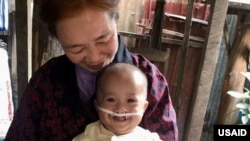The United States recently launched a new five-year, whole-of-government effort to advance protection and care for children in adversity, a Strategy for Children to Thrive.
Children in adversity are those who live under conditions of serious deprivation and danger. This may include children who have no family to care for them; children who have been trafficked; kids who experience violence, are subjected to forced labor or live in regions plagued by armed conflict, humanitarian crises, or natural hazards. Experiencing such conditions in early childhood can lead to lifelong problems.
“If we want any of our other development efforts to succeed, it's really important to start with those early years,” said USAID Deputy Assistant Administrator Dr. Bama Athreya.
“There is widespread agreement that we have to protect those children who are most vulnerable in the world. Widespread agreement that we have a moral imperative to take care of children who have been separated from their families or have lost a parent or caregiver.”
“The U.S. government Thrive strategy has three objectives,” said Dr . Athreya. “The first objective is building strong beginnings.”
“Eighty percent of brain development happens in the first three years of life. So while it's great that we support primary education and secondary education worldwide, those efforts are going to be all the more effective if we invest in the early years.”
“The second objective of the U.S. Thrive strategy is helping families to thrive as well.”
“We know that children need loving, nurturing care, and they do best when they have that nurturing care in an intimate family setting. But all too many children worldwide have lost parents or caregivers. … What we're doing is helping to strengthen the systems that can provide appropriate family care for these children.”
“Finally, the third objective of the Thrive strategy is protecting children from violence,” said Deputy Assistant Administrator Athreya.
“All too many children, when they lack that nurturing wraparound care and those people to protect them, are extremely vulnerable to harm and to exploitation. We need to stop the perpetration of violence against children. … We need systems that hold perpetrators accountable and that provide the services that traumatized children may need.”
“Children who are safe at home and in the schools have a better chance of thriving throughout their lives,” said Deputy Assistant Administrator Athreya. “This is a moral imperative and it is also a developmental imperative.”
New U.S. Strategy to Protect Kids in Adversity

The United States recently launched a new effort to advance protection and care for children in adversity. USAID Deputy Assistant Administrator Dr. Bama Athreya provides exclusive commentary.


















